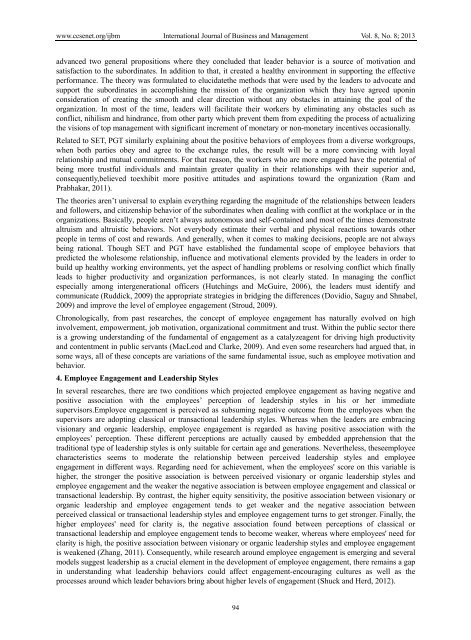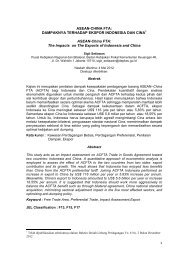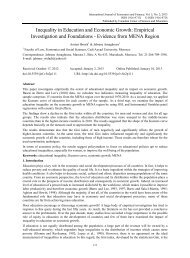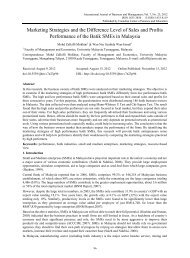The%20Effects%20of%20Perceived%20Leadership%20Styles%20and%20Organizational
The%20Effects%20of%20Perceived%20Leadership%20Styles%20and%20Organizational
The%20Effects%20of%20Perceived%20Leadership%20Styles%20and%20Organizational
Create successful ePaper yourself
Turn your PDF publications into a flip-book with our unique Google optimized e-Paper software.
www.ccsenet.org/ijbm International Journal of Business and Management Vol. 8, No. 8; 2013<br />
advanced two general propositions where they concluded that leader behavior is a source of motivation and<br />
satisfaction to the subordinates. In addition to that, it created a healthy environment in supporting the effective<br />
performance. The theory was formulated to elucidatethe methods that were used by the leaders to advocate and<br />
support the subordinates in accomplishing the mission of the organization which they have agreed uponin<br />
consideration of creating the smooth and clear direction without any obstacles in attaining the goal of the<br />
organization. In most of the time, leaders will facilitate their workers by eliminating any obstacles such as<br />
conflict, nihilism and hindrance, from other party which prevent them from expediting the process of actualizing<br />
the visions of top management with significant increment of monetary or non-monetary incentives occasionally.<br />
Related to SET, PGT similarly explaining about the positive behaviors of employees from a diverse workgroups,<br />
when both parties obey and agree to the exchange rules, the result will be a more convincing with loyal<br />
relationship and mutual commitments. For that reason, the workers who are more engaged have the potential of<br />
being more trustful individuals and maintain greater quality in their relationships with their superior and,<br />
consequently,believed toexhibit more positive attitudes and aspirations toward the organization (Ram and<br />
Prabhakar, 2011).<br />
The theories aren’t universal to explain everything regarding the magnitude of the relationships between leaders<br />
and followers, and citizenship behavior of the subordinates when dealing with conflict at the workplace or in the<br />
organizations. Basically, people aren’t always autonomous and self-contained and most of the times demonstrate<br />
altruism and altruistic behaviors. Not everybody estimate their verbal and physical reactions towards other<br />
people in terms of cost and rewards. And generally, when it comes to making decisions, people are not always<br />
being rational. Though SET and PGT have established the fundamental scope of employee behaviors that<br />
predicted the wholesome relationship, influence and motivational elements provided by the leaders in order to<br />
build up healthy working environments, yet the aspect of handling problems or resolving conflict which finally<br />
leads to higher productivity and organization performances, is not clearly stated. In managing the conflict<br />
especially among intergenerational officers (Hutchings and McGuire, 2006), the leaders must identify and<br />
communicate (Ruddick, 2009) the appropriate strategies in bridging the differences (Dovidio, Saguy and Shnabel,<br />
2009) and improve the level of employee engagement (Stroud, 2009).<br />
Chronologically, from past researches, the concept of employee engagement has naturally evolved on high<br />
involvement, empowerment, job motivation, organizational commitment and trust. Within the public sector there<br />
is a growing understanding of the fundamental of engagement as a catalyzeagent for driving high productivity<br />
and contentment in public servants (MacLeod and Clarke, 2009). And even some researchers had argued that, in<br />
some ways, all of these concepts are variations of the same fundamental issue, such as employee motivation and<br />
behavior.<br />
4. Employee Engagement and Leadership Styles<br />
In several researches, there are two conditions which projected employee engagement as having negative and<br />
positive association with the employees’ perception of leadership styles in his or her immediate<br />
supervisors.Employee engagement is perceived as subsuming negative outcome from the employees when the<br />
supervisors are adopting classical or transactional leadership styles. Whereas when the leaders are embracing<br />
visionary and organic leadership, employee engagement is regarded as having positive association with the<br />
employees’ perception. These different perceptions are actually caused by embedded apprehension that the<br />
traditional type of leadership styles is only suitable for certain age and generations. Nevertheless, theseemployee<br />
characteristics seems to moderate the relationship between perceived leadership styles and employee<br />
engagement in different ways. Regarding need for achievement, when the employees' score on this variable is<br />
higher, the stronger the positive association is between perceived visionary or organic leadership styles and<br />
employee engagement and the weaker the negative association is between employee engagement and classical or<br />
transactional leadership. By contrast, the higher equity sensitivity, the positive association between visionary or<br />
organic leadership and employee engagement tends to get weaker and the negative association between<br />
perceived classical or transactional leadership styles and employee engagement turns to get stronger. Finally, the<br />
higher employees' need for clarity is, the negative association found between perceptions of classical or<br />
transactional leadership and employee engagement tends to become weaker, whereas where employees' need for<br />
clarity is high, the positive association between visionary or organic leadership styles and employee engagement<br />
is weakened (Zhang, 2011). Consequently, while research around employee engagement is emerging and several<br />
models suggest leadership as a crucial element in the development of employee engagement, there remains a gap<br />
in understanding what leadership behaviors could affect engagement-encouraging cultures as well as the<br />
processes around which leader behaviors bring about higher levels of engagement (Shuck and Herd, 2012).<br />
94









